#Mount Horai
Explore tagged Tumblr posts
Text
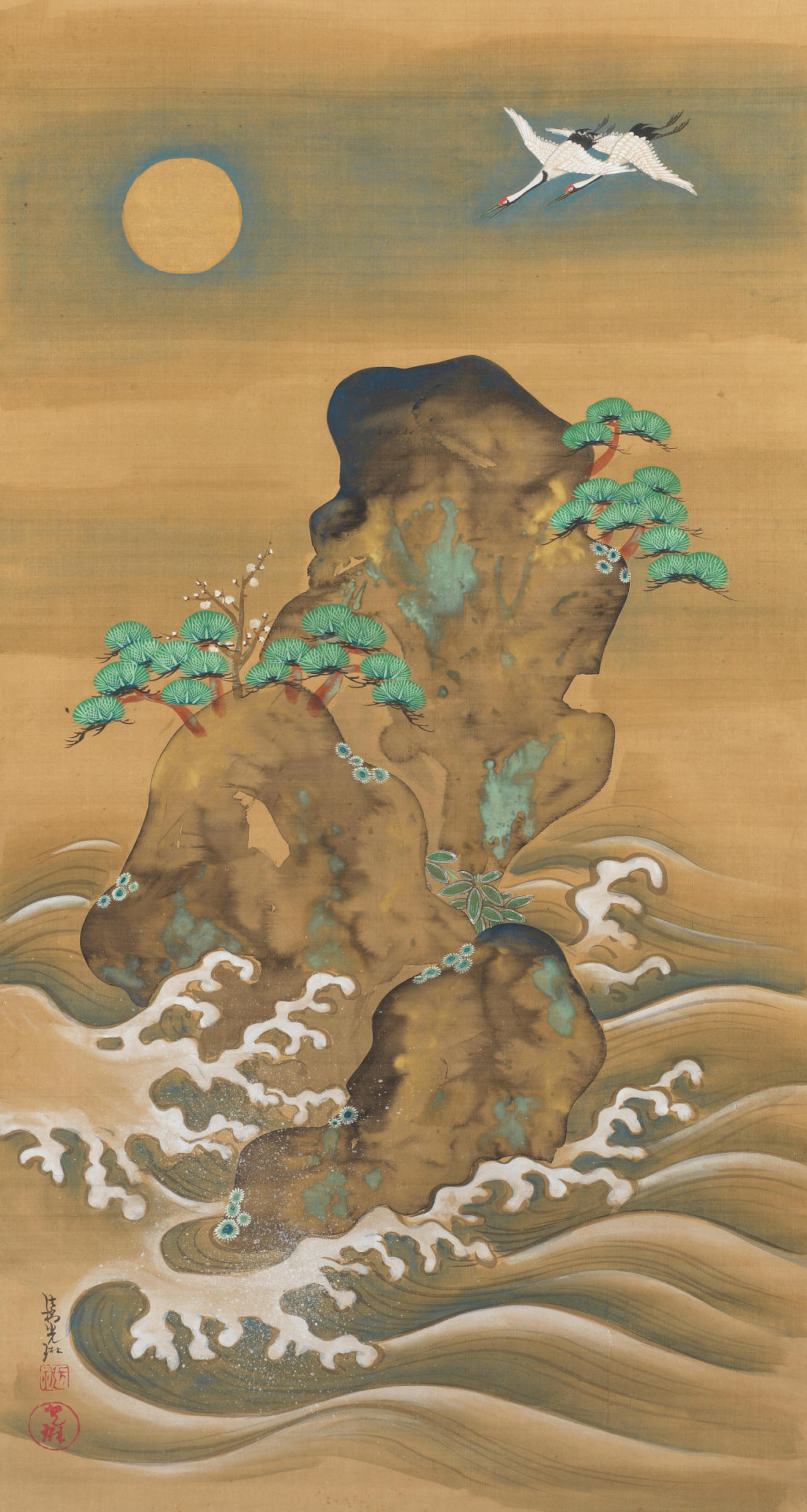
Sakai Dōitsu (1845-1913) — Mount Horai [hanging scroll; ink, colours, gold, on silk, ca. 1889]
136 notes
·
View notes
Text
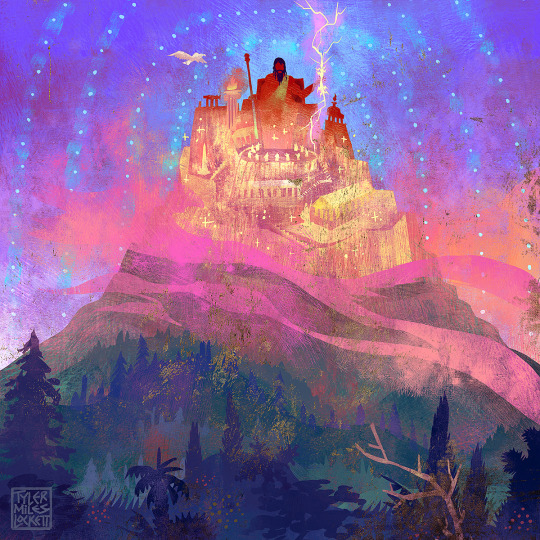
Mount Olympus: Home of the Olympians
The real-world Mount Olympus is the highest peak in Greece and is located between the borders of Thessaly and Macedonia. The kingdom of the gods sits high upon the mountain as a majestic, bronze Acropolis (fortified hill top citadel). In Homer’s Iliad and Odyssey we get our earliest references, where the peaks of Olympus are described as “rugged’ or “cloud-dark” and the acropolis described as “bronze-founded” and “under golden clouds.” (Lattimore). The fortress sits below the great sky dome, within in a specific position upon the mountain, in the light, blue upper air of Aether. Below that was the middle air Khaos which enveloped mortals, and finally the lower, dark subterranean mists of Erebos.
Guarding the gates were the goddesses of Seasons, constellations, and time; the Horai. Within the fortress complex was Zeus’ grand palace, along with the lesser palaces of other Olympians, and a divine stable for many of the different gods’ immortal chariot horses. In the golden court, the Olympians held councils to decide mortals’ fates, and feast-hall style banquets; drinking sweet, magical Nectar from golden goblets and eating restorative Ambrosia to maintain immortality by sustaining the fluid within the gods veins; Ichor. Twenty golden tripod Automotons (programmed machines), ingeniously invented by the smith god Hephaestus, autonomously wheeled food and drink amongst the deities.
Did I miss any fascinating info about Olympus? Please let me know below! And if you can share this image with your followers I'll be happy to send you over an automaton with a goblet of ambrosia to keep your ichor running clear!😁🤟❤️
Support my book kickstarter "Lockett Illustrated: Greek Gods and Heroes" coming in early 2024.
#pagan#hellenism#greek mythology#tagamemnon#mythology tag#percyjackson#dark academia#greek#greekmyths#classical literature#percy jackon and the olympians#pjo#homer#iliad#classics#mythologyart#art#artists on tumblr#odyssey#literature#ancientworld#ancienthistory#ancient civilizations#ancientgreece#olympians#greekgods#agamemnon#troy#trojanwar
336 notes
·
View notes
Note
TELL ME ABOUT LUNA'S PLANET!!! THE FRUIT PLANTS, THE GREENERY, I GOTTA KNOW WHAT THE HYDROSPHERE IS LIKE
OH YOU ARE SO SLAY FOR THIS MY MYOOCH!!!!
Iego is separated into two main biome-regions--Luxayang (the lightlands) and Noktayin (the darklands)--that take up equal space on the planet. Luxayang is made up of lush jungles and sandstone cliffs, rich in flora and fauna of all kinds, whereas Noktayin is made up of barren canyons and basalt spires. If it wasn't obvious enough, both regions correspond to areas rich in the Light and Dark sides of the Force, respectively.
As there are no fields large enough for farming--there's a bit of terrace farming on mountainsides, but that's it--the people who reside in the Luxayang region partially sustain themselves with the ample fruits and vegetables available. As the planet experiences no real cycle of seasons, plants grow and produce year-round, offering a very stable and reliable food source. In Meru especially, there are seemingly boundless berry bushes and fruit trees growing in the village. Drawing from the Force properties of the area, all edible plants have great medicinal value, too, and are widely used in both Iegoan cuisine and traditional medicine.
As for the hydrosphere, well... Iego has no oceans, nor any real bodies of water on the surface of the planet. The only source of water on the surface of the planet are the Sacred Falls and the Pools of Lustration of Mount Horai, in the heart of the village of Meru. Both places are featured heavily in the native religion of Drolism, regarded as the holy grounds of the Gods, flowing with the ichor of the planet that in myth is regarded as an elixir of immortality. Traditionally, the people of Meru would rely on collected rainwater to sustain themselves, leaving the sacred waters untouched, save for specific religious ceremonies and rituals. As the water is purported to have life-sustaining properties, it is used in ritual healing by the triyi, and has been shown to be effective.
30 notes
·
View notes
Text
What areas did Taishou and Sesshoumaru rule over?

Unfortunately there is no official map that shows for what's owned in the series but there are some for real life!
The dog demon clan hailed from Saigoku. That's the "Western lands" of Japan. Kaede's Village is where Tokyo is to this day.
Ironically now for modern times there's something called the "Saigoku Kannon Pilgrimage" they go through the 33 Buddhist temples on the Kansai region of Japan. Saigoku was really an old term that was also sometimes pronounced as "Saikoku" but today it is called "Kansai" ! "Saigoku" is Kansai (関西), the area of western Japan centering on Kyoto https://www.thetempleguy.org/p/saigoku-33-kannon-route.html Those areas are Hyogo, Kyoto, Shiga, Osaka, Nara and Wakayama
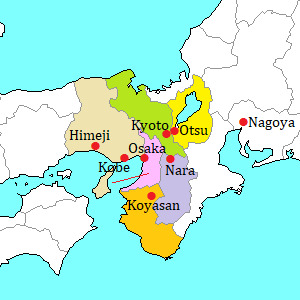
www.travel-around-japan.com/k60-00-kansai-reg.html
Just to note there's a Mistranslation in the Viz media English version of the Yashahime manga that said Taishou came from China but it's actually Saigoku, which is Western lands of Japan it was even addressed on Takashi Shiina's Twitter page. Incase people were confused. https://twitter.com/Takashi_Shiina/status/1542931034517700608 一カ所、「西国」が「Ancient China(古代中国)」と訳されてたので、「これは<日本の西にある国>ではなく、<日本国の西地方>という意味です」と伝言をお願いしておいた。電子版では近日直してもらえるかも。 In one place, ``Saigoku'' was translated as ``Ancient China,'' so I sent a message saying, ``This does not mean ``the country to the west of Japan,'' but ``the western region of Japan.'' I asked for it. The digital version may be fixed soon.
You can see very good maps for history here:
https://timemaps.com/history/japan-1453ad/
For reference on what era you want to look at for InuYasha it's during the 1540s, this was mentioned in InuYasha wide edition #4
In Yashahime manga chapter 23 they're at Sakai. In feudal Japan Sakai is the center of commerce.
Taishou died in the Kamakura period within a castle in Kamakura city. That's 1185-1333 There's been many changes on the earth since those times as well as tsunamis and even seasonal cycles because of tilts. Japan has certainly shrunk over the years because these situations. We also know he's been alive since the Heian period 794-1185 because of how he uses the Dono honorific when talking to Zero and also within the timeline. Midoriko and the Jewel was created in the Heian period according to the InuYasha profiles book timeline.
Kirinmaru, Riku and Rion are from mainland China, yes. In fact Kirinmaru is based on the Qilin of myths and legends which originate from China which were first attested in 5th century BCE which ironically lines up with what Katsuyuki Sumisawas said in Animage May 2021 about him being alive since the era of myth and that he may have seen Buddha or Jesus Christ in the Flesh but not Adam and Eve eat the forbidden fruit.
There are some maps within the series, like Mount Hakurei, Horai Island from the fourth movie. Also the video game counterparts which were all supervised by Rumiko-sensei. - Admin
#inuyasha#犬夜叉#inu yasha#anime#manga#rumiko takahashi#yashahime#hanyou no yashahime#inulysis#inu meta#inumeta
29 notes
·
View notes
Photo
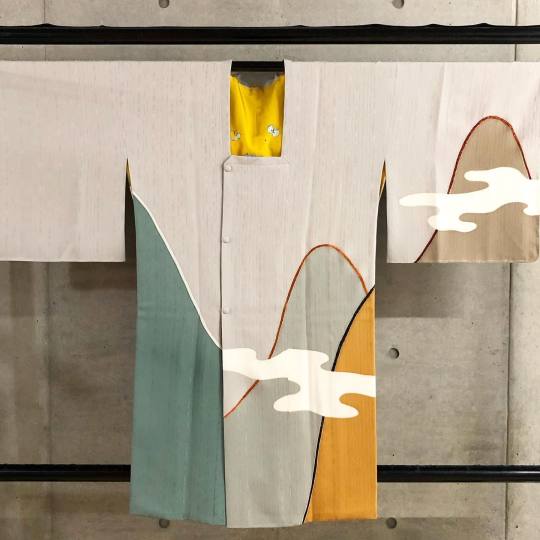
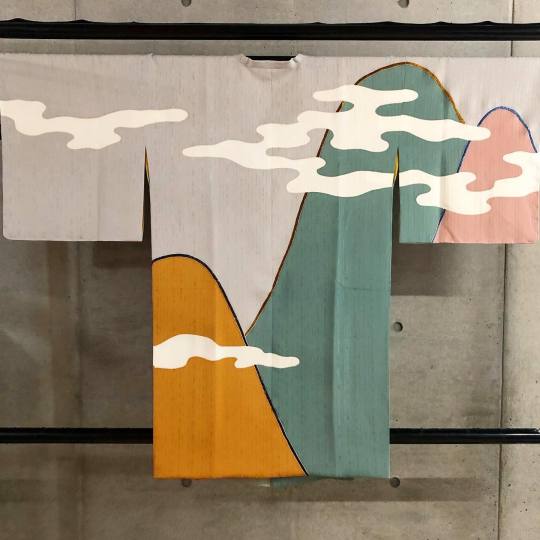
Minimalist modern michiyuki coat by Taiyoukyo, depicting mystical Mount Hourai (a land of Immortals, called Penglai in China) in the mist.
I don’t have a good view of the lovely bright yellow lining but it seems to depict takaramono/takarazukushi (lucky treasures) which usually are:
Uchide no Kodzuchi (lucky mallet)
Fundo (counterweight)
Kinno (treasure pouch)
Kakuregasa (hat of invisibility)
Kakuremino (robe of invisibility) or hagoromo (heavenly feathered robe)
Makimono (scrolls of knowledge)
Shippo (geometrical shape representing jewels and precious metal)
#japan#fashion#kimono#haori#michiyuki#coat#mount horai#hourai#penglai#immortal land#takaramono#takarazukushi#着物#羽織
126 notes
·
View notes
Photo
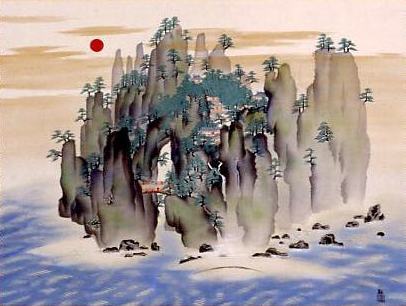
“Hōrai san 蓬莱山” de
Yokoyama Taikan 横山大観 (1868 - 1958).
Un des fondateurs du “nihonga日本画”, son œuvre couvre un demi siècle et il est considéré comme un des maîtres du cercle de peintres de Kyōto d'avant-guerre.
Note : Hōrai san 蓬莱山 - mont imaginaire En Chine, la montagne de Penglai, ou Penglai Shan 蓬萊山, est le lieu où les huit immortels tiennent leur banquet. Ses fruits sont l'élixir de longue vie. san-shinsan 三神山 - trois monts imaginaires issus d'une légende chinoise - Les 3 monts flottaient sur la mer portés par 15 grandes tortues. Ces "Îles-montagnes", étaient habitées par des immortels qui possédaient des trésors rares ainsi que l'élixir de l'immortalité. Il s'agissait également d'une des destinations des Requêtes Impossibles.
31 notes
·
View notes
Photo

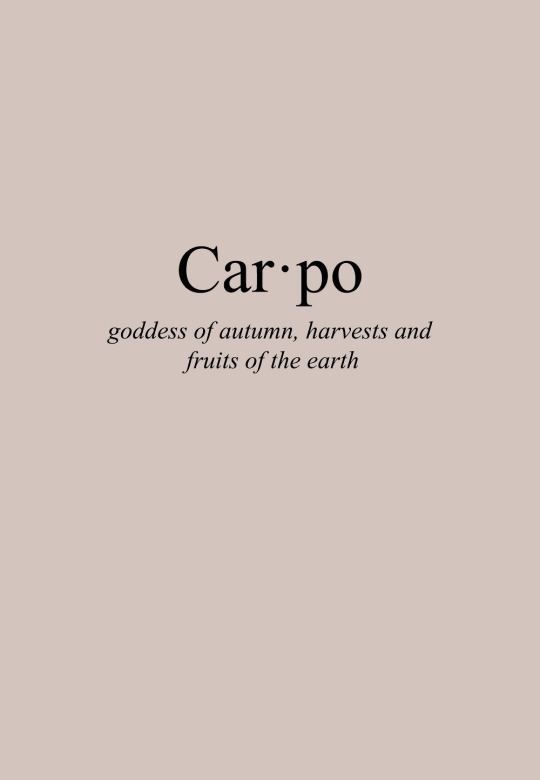

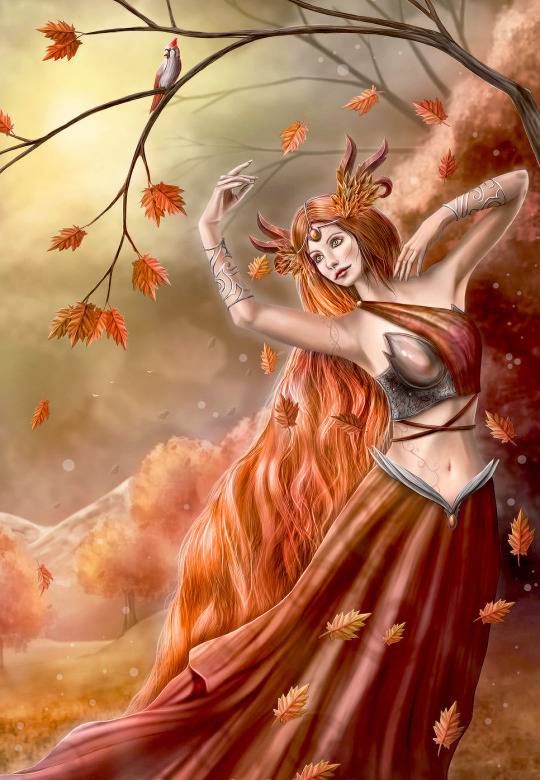
The Evermore Grimoire: Greek Mythology
Carpo (Καρπω meaning ‘Fruit’) was the goddess of autumn, harvests and fruits of the earth in Greek mythology. She guarded the way to Mount Olympus by pulling back the clouds around the mountain if one of the gods left. Carpo was also one of three seasonal goddesses alongside Thallo (goddess of flowering plants) and Auxo (goddess of growth) called the Horai. Whilst the Moirae controlled the destiny of everyone the Horai presided over the revolutions of the heavenly constellations by which the year was measured.
artwork by CLB Ravaneye
683 notes
·
View notes
Link
"Páppa, look!" Ikaros soared above his father, flapping his hand-made wings excitedly. "The sun is all weird!"
"Don't fly too close to the sun, son," Daidalos repeated for the fourth time.
"I know, I know. But LOOK!"
Ikaros had watched and studied the course of the sun and the planets as Daidalos had taught him astronomy and the laws of physics. How the distance of Helios' course was just right or else the world would either burn or freeze. And Ikaros had listened and performed little experiments and he had come to the conclusion that Helios was, indeed, quite dependable. But today... Today the chariot seemed to totter and jump in the sky, not at all the perfectly predictable course Ikaros was used to. He had not taken any measurements as they fled Crete, of course, but he could have sworn it was too early to be noon already.
"By Zeus, Ikaros, focus on your flight!" yelled his father.
Ikaros did. For a few moments. It had gotten notably cooler, even though there was no fresh wind coming from the sea nor clouds blocking the sun's warm rays. Ikaros didn't care what his father said. He just HAD to find out what happened up there!
~~~
"Take Phosphoros, the Morning Star, as guide to lead the way for your car, and you will not go astray."
So spoke Helios as he crowned his son with his own fire, winding the rays like strings upon his hair, and clothed him in his bright robe.
"I will, father, I will!"
Phaëthon still couldn't believe he would drive the sun chariot today. His father's crown felt warm without burning him and the unearthly radiance made him feel special.
Helios laced his feet into the purple boots himself, as if he were but a servant.
"Now there is nothing left to give you but my gleaming whip and the chariot itself."
He bade the beautiful Horai to go yoke his steeds with shaky voice.
"Thank you, father!" Phaëthon looked himself up and down, amazed with the fiery beauty of his borrowed clothes.
"You can still reconsider." Helios knitted his shining brows. "Ask the greatest blessing of the sky, or sea or land, and I will gladly give it freely."
The swift goddesses soon returned with fastened golden harness and the shining reins, leading the horses breathing flame. Phaëthon stared in awe at the glittering chariot, its golden wheels and silver spokes. How could he reconsider?!
"No, father, I told you what I want."
Helios took the reins and gave his chariot to his son. Phaëthon mounted eagerly and took the shining reins from his father and the gleaming whip.
"My beloved child, before you go..." Helios held him to his breast with caressing arms. "I wish you had never asked me for this favour but please, be sure that whatever happens, I am proud of you."
Phaëthon gave his father a farewell kiss.
"See you in the West!"
And off he went.
Read the full story on Patreon!
Falling for the Son has two sexy illustrations created by Arabella "Arja" Salvini. You may know her as one of the creators of the comic The Last Bacchae, a story around Dionysos set in modern times! Follow the comic on Facebook, Twitter, and @thelastbacchae here on Tumblr 💜
62 notes
·
View notes
Photo

Mount Horai, Komuro Suiun, first half 20th century, Minneapolis Institute of Art: Japanese and Korean Art
colorful landscape; steep cliff along R with path leading to a shrine just visible between rocks; pine trees at top of cliff at center; tall, jagged mountains in mist in background; a flock of cranes fly in front of sun at UL; churning ocean at bottom Size: 46 × 16 3/8 in. (116.84 × 41.59 cm) (image) 77 7/8 × 21 1/16 in. (197.8 × 53.5 cm) (mount, without roller) Medium: ink and color on silk
https://collections.artsmia.org/art/117068/
18 notes
·
View notes
Text
Selene – The Greek Moon Goddess
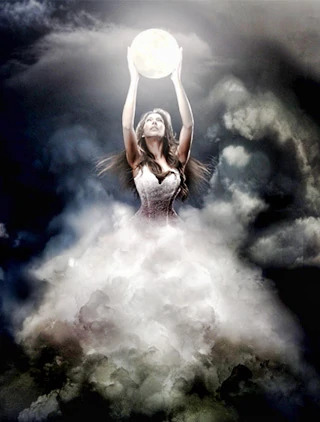
In Greek mythology, Selene was the Titan goddess of the moon. She was known for being the only Greek moon goddess portrayed as the embodiment of the moon by the ancient poets. Selene featured in few myths, with the most famous ones being the tales that tell of her lovers: Zeus, Pan and the mortal Endymion. Let’s take a closer look at her story.
Selene’s Origins
As mentioned in Hesiod’s Theogony, Selene was the daughter of Hyperion (the Titan god of light) and Theia (also known as Euryphessa), who was his wife and also his sister. Selene’s siblings included the great Helios (the god of the sun) and Eos (the goddess of dawn). However, in other accounts, Selene is said to be the daughter of either Helios, or the Titan Pallas, son of Megamedes. Her name is derived from ‘Selas’, the Greek word meaning light and her Roman equivalent is the goddess Luna.
Selene and her brother Helios were said to have been very close siblings who worked well together as the personifications of the moon and the sun, the most significant features of the sky. They were responsible for the movement of the sun and moon across the sky, bringing forth the daylight and night.
Selene’s Consorts and Offspring
While Endymion is possibly Selene’s most famous lover, she had several other lovers aside from Endymion. According to ancient sources, Selene was also seduced by Pan, the god of the wild. Pan disguised himself with white fleece and then slept with Selene, after which he gave her a white horse (or white oxen) as a gift.
Selene had several children, including:
With Endymion, Selene was said to have had fifty daughters, known as the ‘Menai’. They were the goddesses who presided over the fifty lunar months.
According to Nonnus, the pair were also the parents of the stunningly handsome Narcissus, who fell in love with his own reflection.
Some sources say that Selene gave birth to the Horai, the four goddesses of the seasons, by Helios.
She also had three daughters with Zeus, including Pandia (the goddess of the full moon), Ersa, (the personification of dew) and the nymph Nemea. Nemea was the eponymous nymph of the town called Nemea where Heracles had slain the deadly Nemean Lion. It was also the place where the Nemean Games were held every two years.
In some accounts, Selene and Zeus were said to be the parents of Dionysus, the god of wine and theater, but some say that Dionysus actual mother was Semele and that Selene’s name had been confused with hers.
Selene also had a mortal son called Museaus, who became a legendary Greek poet.
Selene’s Role in Greek Mythology
As the goddess of the moon, Selene was responsible for controlling the movement of the moon across the sky during the night. She shone magnificent silvery light down on the Earth as she travelled in her chariot pulled by snowy white horses. She had the power to give the mortals sleep, to light up the night and control time.
Like most other deities of the Greek pantheon, Selene was revered not only as the goddess of her domain, but also as a deity for agriculture and in some cultures, fertility.
Selene and the Mortal Endymion
One of the most well-known myths in which Selene appeared was the story of herself and Endymion, a mortal shepherd who had exceptionally good looks. Endymion often tended his sheep at night and Selene happened to notice him while she was on her nightly journey across the sky. Taken by his looks, she fell in love with Endymion and wished to be with him for eternity. However, being a goddess, Selene was immortal whereas the shepherd would age over time and die.
Selene begged Zeus to help her and Zeus took pity on the goddess who was besotted by the handsome shepherd. Instead of making Endymion immortal, Zeus, with the help of Hypnos, the god of sleep, made Endymion fall into an eternal sleep from which he would never wake. The shepherd did not age from that point on, nor did he die. Endymion was placed in a cave on Mount Latmos which Selene visited every night and she continued to do so for all eternity.
In some versions of the story, Zeus woke Endymion and asked him what kind of life he would prefer to lead. Endymion had also lost his heart to the beautiful moon goddess so he asked Zeus to make him sleep forever, bathed in her warm, soft light.

The poem Endymion by John Keats, with its legendary opening lines, goes on to retell the story of Endymion.
Depictions and Symbols of Selene
The moon was of great importance to the ancient Greeks who measured the passage of time by it. A month in Ancient Greece consisted of three ten day periods which were based entirely on the different phases of the moon. It was also a common belief that the moon brought dew with it to nourish animals and plants. Therefore, as the goddess of the moon, Selene had an important place in Greek mythology.
The moon goddess was traditionally depicted as a stunningly beautiful young maiden, with slightly paler skin than usual, long black hair and a cloak billowing above her head. She was often portrayed with a crown on her head that represented the moon. Sometimes, she would be riding a bull or a silver drawn by winged horses. The chariot was her form of transport each night and like her brother Helios, she travelled across the sky bringing the moonlight with her.
There are several symbols associated with the goddess of the moon including:
Crescent – the crescent symbolizes the moon itself. Many depictions feature a crescent on her head.
Chariot – the chariot signifies her vehicle and mode of transportation.
Cloak – Selen was often depicted with a billowing cloak.
Bull – One of her symbols is the bull which she rode upon.
Nimbus – In certain works of art, Selene is portrayed with a halo (also known as the nimbus), surrounding her head.
Torch – During the Hellenistic period, she was pictured holding a torch.
Selene is often depicted together with Artemis, the goddess of the hunt, and Hecate, the goddess of witchcraft, who were also goddess associated with the moon. However, of the three, it was Selene who was the sole moon incarnate as we know it to be today.
The story of Selene and Endymion became a popular subject for Roman artists, who depicted it in funerary art. The most famous image was that of the moon goddess holding her billowing veil over her head, descending from her silver chariot to join Endymion, her lover who lies asleep at her feet with eyes open so that he may gaze upon her beauty.
Worship of Selene
Selene was worshipped on the days of the full and new moons. The people believed that she was at the she had the ability to bring forth new life on these days and was invoked by women who wished to conceive. They prayed to the goddess and made offerings to her, asking for inspiration and fertility. However, she wasn’t known as a fertility goddess.
In Rome, there were temples dedicated to her as the Roman goddess Luna, on the Palatine and Aventine hills. However, there were no temple sites dedicated to the goddess in Greece. According to various sources, this was because she was always seen and worshipped from almost every point on Earth. The Greeks worshipped her by gazing on her magnificent beauty, offering libations to the goddess and reciting hymns and odes.
Facts About Selene
Is Selene an Olympian?
Selene is a Titaness, the pantheon of deities that existed before the Olympians.
Who are Selene’s parents?
Selene’s parents are Hyperion and Theia.
Who are Selene’s siblings?
Selene’s siblings are Helions (sun) and Eos (dawn).
Who is Selene’s consort?
Selene is associated with several lovers, but her most famous consort is Endymion.
Who is Selene’s Roman equivalent?
In Roman mythology, Luna was the goddess of the moon.
What are Selene’s symbols?
Selene’s symbols include the crescent, chariot, bull, cloak and torch
In Brief
Although Selene was once a famous deity in ancient Greece, her popularity has waned and she is now less well-known. However, those who know her continue to worship her whenever there is a full moon, believing the goddess is at work, traversing in her snowy chariot and lighting up the dark night sky.
https://symbolsage.com/selene-greek-moon-goddess/
3 notes
·
View notes
Photo
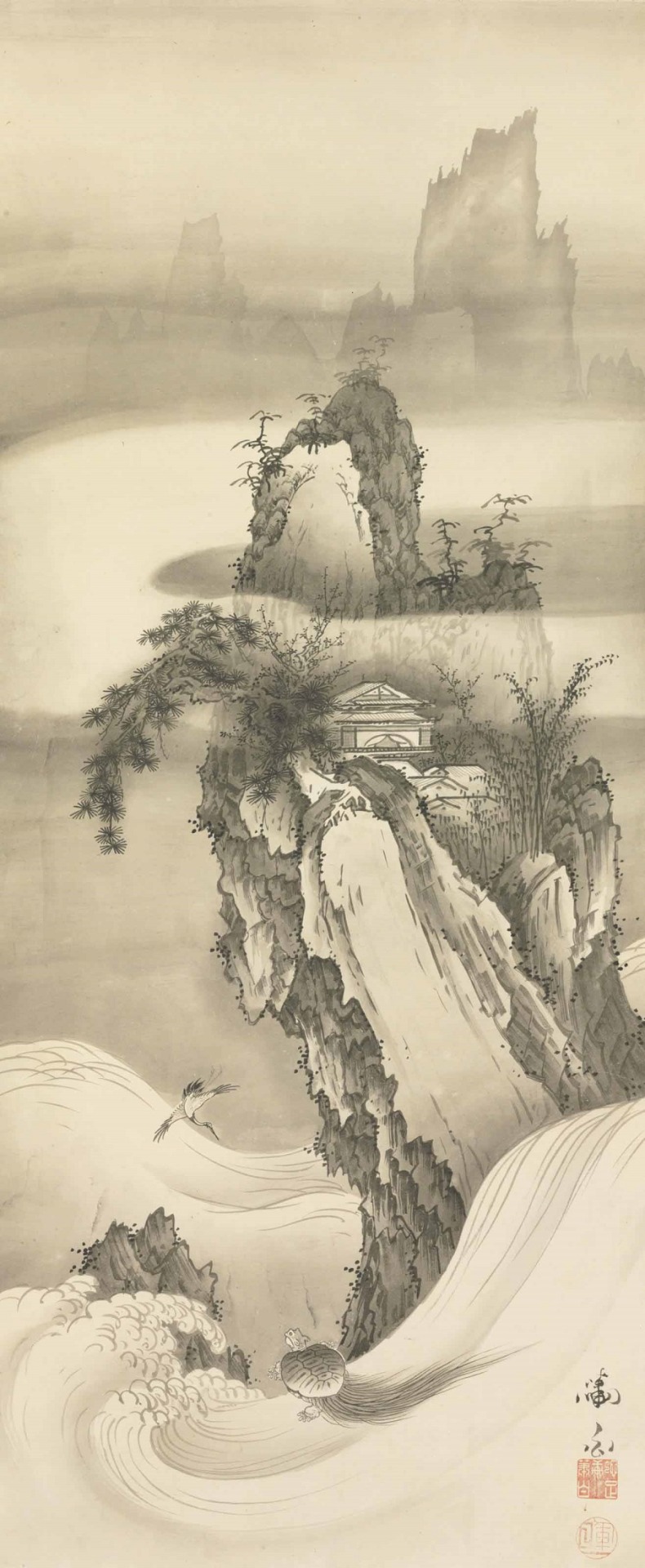
Soga Shohaku (1730-1781) Mount Horai Signed Shohaku, sealed Dasokuken Shohaku and Terukazu Hanging scroll; ink on paper 51 ¼ x 21 ¾ in. (130.2 x 55.2 cm.) With wood box Christie's
274 notes
·
View notes
Photo

Mount Horai, Kano Isen'in, 1802, Art Institute of Chicago: Asian Art
Clarence Buckingham Collection Size: 27.3 x 251.4 cm Medium: Pair of handscrolls; ink and colors on silk
https://www.artic.edu/artworks/12813/
2 notes
·
View notes
Text
The real-world Mount Olympus is the highest peak in Greece and is located between the borders of Thessaly and Macedonia. The kingdom of the gods sits high upon the mountain as a majestic, bronze Acropolis (fortified hill top citadel). In Homer’s Iliad and Odyssey we get our earliest references, where the peaks of Olympus are described as “rugged’ or “cloud-dark” and the acropolis described as “bronze-founded” and “under golden clouds.” (Lattimore). The fortress sits below the great sky dome, within in a specific position upon the mountain, in the light, blue upper air of Aether. Below that was the middle air Khaos which enveloped mortals, and finally the lower, dark subterranean mists of Erebos.
Guarding the gates were the goddesses of Seasons, constellations, and time; the Horai. Within the fortress complex was Zeus’ grand palace, along with the lesser palaces of other Olympians, and a divine stable for many of the different gods’ immortal chariot horses. In the golden court, the Olympians held councils to decide mortals’ fates, and feast-hall style banquets; drinking sweet, magical Nectar from golden goblets and eating restorative Ambrosia to maintain immortality by sustaining the fluid within the gods veins; Ichor. Twenty golden tripod Automotons (programmed machines), ingeniously invented by the smith god Hephaestus, autonomously wheeled food and drink amongst the deities.
Did I miss any fascinating info about Olympus? Please let me know below! And if you can share this image with your followers I'll be happy to send you over an automaton with a goblet of ambrosia to keep your ichor running clear!😁🤟❤️
Support my book kickstarter "Lockett Illustrated: Greek Gods and Heroes" coming in early 2024.
#pagan#hellenism#greek mythology#tagamemnon#mythology tag#percyjackson#dark academia#greek#greekmyths#classical literature#percy jackon and the olympians#pjo#homer#iliad#classics#mythologyart#art#artists on tumblr#odyssey#literature#ancientworld#ancienthistory#ancient civilizations#ancientgreece#olympians#greekgods#agamemnon#troy#trojanwar
28 notes
·
View notes
Text
Atop Mount Penglai [Fic] [Inuyasha]
Title: Atop Mount Penglai Characters: Inuyasha & Co., the hanyo kids from the fourth movie Fandom: Inuyasha Genre: Gen, Friendship, Future Fic Rating: G Word Count: 704
Written for @acquasole as part of the @inusecretsanta 2019 exchange. Prompt was: The hanyo kids from the fourth movie meeting up with inuyasha and co after the Final Act. Merry (belated) Christmas and Happy New Year! :)
Utopia lost then found again.
Atop Mount Penglai
Well before they reached the peak, they could hear music resonate. A stirring (familiar) crescendo soaring high. At first faint then clear and deep and powerful.
"It's Asagi-chan!" Kagome exclaimed excitedly.
"Yup, that's her alright," Inuyasha concurred. "I'd recognize her voice anywhere."
"How many years has it been?" Sango asked.
"Nine or ten," Miroku replied. "It's uncanny to think that that much time has passed since Horai Island."
With a cheeky smirk, Shippou retorted, "Ten years might seem a lot to you humans, but for those with yokai heritage, it's inconsequential—unless you're Inuyasha."
"Wanna say that again, you little brat?"
"Now, now, let's not fight amongst ourselves," Miroku calmly interjected (supported by a growl from Kirara). "This is supposed to be a…what's that word again, Kagome-sama?"
"Holiday. We're here to relax and have a good time. Which means you better be nice, Inuyasha!"
"Yeah, yeah, I know," he scoffed.
"Let's keep moving," said Sango. "We still have a while to go."
And so they climbed up the mountainside, scaling past gorges and ravines. Beyond the clouds, above the terrain of men, and toward the vast firmament. To Mount Penglai's summit where a hidden haven beckoned.
--
Ai was the first to greet them upon their arrival. Perched atop a boulder, grinning wide, she ushered for them to follow.
"Asagi-nee-san and the others are just inside," Ai cheerily relayed. "There's so much you have to see!"
As the mists dispelled, a small village emerged. A dozen or so modest huts assembled around a shrine dedicated in honor of Lady Kanade. And in the center were the other children they remembered. Unchanged (unaltered) yet somehow different.
They're happy, Kagome realized. Unfettered by fate or gods.
They were truly free.
--
With a thunderous bang, the twins crashed through the slatted door. Snickering, identical to the marrow (save for the hair), Roku and Dai awoke their guests. The boys set down platters of steaming rice, sweet, crunchy pickles, and savory, freshly caught fish. Trailing a pace behind, Shion shyly announced that their tour would commence following breakfast.
There was much to be shown (a hard and long decade's worth of accomplishments).
For this was their dream and sanctuary. Their pride. And none of it would be possible had it not been for that chance encounter all those years ago.
--
"That's where we store provisions for winter," Moegi explained. "And that's where newcomers stay until their houses are built. Over thirty hanyos are here now, but only half have homes of their own."
"Do you expect more to come?" Miroku inquired.
"Oh yes. We already have news that another group of refugees are on their way here. Asagi-nee-san wants to make this place what Horai originally was. Somewhere for yokai and humans to live together in harmony."
Nodding, Sango murmured, "It's a beautiful goal."
(And sincerely hoped they would achieve it.)
--
When he was a child, Inuyasha always dreaded the new moon. Swathed in darkness, bereft of light and sight, he transformed (was reduced) to a mortal. A cycle of misery and reminder that he was an outcast.
Yokai scorned him. Humans feared him. And both rejected him.
An abomination can never be one of us.
But as he stood on the mountain's precipice, atop the earth (above ages-entrenched prejudices), the remnant echoes of their curses ceased to exist. Although he might never be accepted by the universe at large, he was happy to know there was a speck, a tiny corner of the cosmos, for those like him.
Head tipped heavenward, Inuyasha squeezed back Asagi's hand.
"Thank you, Inuyasha-onii-chan," she said softly.
"For what?"
"For helping me believe again."
--
The final evening of their visit culminated in a grand performance and delicious banquet. Songs and somersaults, leaps and feats. Laughter abounded the twilit sky. Gathered around a blazing bonfire, surrounded by friends newfound and old, they felt cozy and warm.
Perfectly at peace—everything just right.
As the world should be.
*Penglai is Horai in Chinese. It's a mythical mountain/island where the Eight Immortals reside.
7 notes
·
View notes
Text
Greek Gods You’ve Never Heard Of, Part IV
More Personified Concepts
Dike/Dice (f) “justice”, moral order, fair judgment, socially enforced norms, conventional rules. Young slender woman carrying a scale with a laurel wreath. Represented in the constellation Libra. Roman: Justitia
Astraea/Astrea/Astria (f) “star maiden/starry night” Virgin goddess of innocence and purity, and associated with Dike (justice). the last of the immortals to live with humans during the Golden Age. Abandoned earth during the Iron Age. Became Virgo, next to Libra.
Adikia/Adicia (f) injustice, wrongdoing. Opposite of Dike
Angelia (f) daughter of Hermes, daemon of messages, tidings, proclamations (if this sounds like the word “angel”, it’s because our word angel comes from the same root: Greek “angelos”, meaning “messenger”)
Harmonia (f) harmony and concord. opposite of Eris (strife). (Also the name of a nymph of the Akmonian Wood, mother of the Amazons.) Wife of Cadmus, first king of Thrace. Sister of----->
Iasion/Iasus/Eetion, founder of the mystic rites on Samothrace; with Demeter fathered Ploutos, Philomelus, and Corybas, who gave his name to the Corybantes/Koribantes, dancing priests of Phrygia
Hedone (f) pleasure, especially sensual pleasures. daughter of Eros and Psyche; opposite of the Algos (pains). Roman: Voluptas
-----Four winged enforced siblings stood in attendance at Zeus’s throne: Zelus, Bia, Kratos, and Nike, children of the titans Pallas (m) and Styx (f). Along with their mother, they helped Zeus in the war against the Titans and became his constant companions after he triumphed.
Kratos/Cratos (m) daemon of strength
Nike (f) “victory,” goddess of victory, strength, speed. Associated with Athena. winged goddess. Roman: Victoria
Zelus/Zelos (m) “zeal.” Zelus and Bia were less famous than Cratos and Nike.
Bia (f) "Power, force & Might" was the personification of force and raw energy. when Prometheus was punished and was to be chained to a rock, Bia and her brother, Kratos, were sent to carry out this task, but Bia was the only one strong enough to actually bind Prometheus to the rock with the unbreakable chains.
Lampetia (f) “shining,” daemon of light. daughter of Helios (sun) and Neaera (nymph of Thrinacia), she and her sister Phaethusa guarded the ageless and deathless sheep and cattle of Thrinacia.
Phaethusa (f) “radiance”, daemon of the brilliant, blinding rays of the sun
Mnemosyne (f) memory. a titaness, mother of the Muses. Roman: Moneta
Polemos (m) “war,” daemon of war. Roman: Bellum
Pandia/Pandeia (f) “all brightness”, associated with the full moon. daughter of Zeus and Selene (moon)
Agon (m) struggle, contest
Phthonus (m) jealousy, envy, especially in love
the Horae/Horai/Hours (f, plural) “seasons,” goddesses of the seasons and the natural portions of time. sometimes goddesses of order in general, and natural justice. usually 3: Thallo, Auxo, and Carpo (the order of nature); or Eunomia (good order, lawful conduct) and her sisters Dike (justice) and Eirene (peace). in Argos there were two, winter and summer: Auxesia (possibly Auxo) and Damia (possibly Carpo).
First triad of the Horae, children of Aphrodite and Zeus:
Thallo/Thalette “the one who brings blossoms”, spring, buds, blooms, protectors of youth. Roman: Flora
Auxo/Auxesia “increaser”, summer, vegetation, plants, growth, fertility
Carpo/Carpho/Xarpo, the one who brings food, autumn, ripening, harvesting. Guarded the way to Mount Olympus
Second triad, children of Themis and Zeus
Dike “Justice”, moral justice, ever-young woman dwelling in the cities of man, Virgo. Roman: Iusticia (see Dike, Astraea: above)
Eunomia “order”, goddess of law and legislation
Eirene/Irene “peace”, peace and wealth, beautiful young woman carrying cornucopia, scepter, and torch or rhyton. Roman: Pax
Third triad:
Pherusa, substance, farm estates
Euporie/Euporia, abundance
Orthosie/Orthosia, prosperity
The Horae as the four seasons:
Eiar (spring), Theros (summer), Phthinoporon (autumn), Cheimon (winter)
The Horae as the hours: tutelary goddesses of the times of day
9 hour system:
Auco/Auxo, Eunomia, Pherusa, Carpo, Dike, Euporie/Euporia, Eirene/Irene, Orthosie/Orthosia, Thallo
10 or 12 hour system:
Auge (first light) not original to the set
Anatole/Anatolia (sunrise)
Mousike/Musica (morning hours of music and study)
Gymnastike/Gymnastica/Gymnasia (morning hours of education, training, exercise)
Nymphe/Nympha (morning hours of ablution/bathing)
Mesembria (noon)
Sponde (libations poured after lunch)
Elete (prayer, first of the afternoon work hours)
Akte/Acte/Cypris (eating and pleasure, 2nd of the afternoon work hours)
Hesperis (end of the afternoon, start of evening)
Dysis (sunset)
Arktos/Arctus (night sky, constellation) not original to the set
(See the rest of the series)
187 notes
·
View notes
Photo

"A lovely image of a Japanese Bride, wearing a beautiful Uchikake (outer kimono) decorated with a Bamboo, Pine and Plum Blossom motif, known as the "three friends of winter", an auspicious grouping often associated with the marriage ceremony, the motif represents Mount Horai and the wish for a long and happy life for the new couple. " Photograph taken in the 1910's, Japan. Text and image via Blue Ruin 1 of Flickr
671 notes
·
View notes